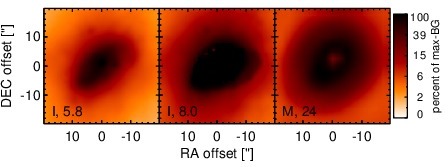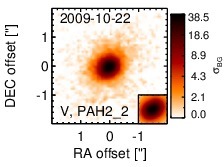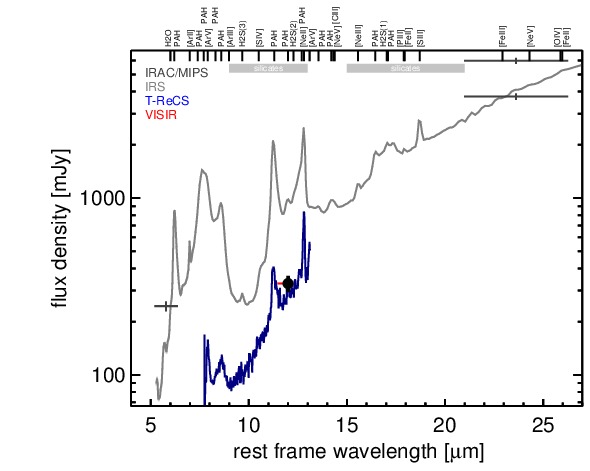Sasmirala Individual Information for NGC 1808
Description
NGC 1808 is an inclined peculiar spiral galaxy at a distance of D = 12.3 ± 2.2 Mpc [tully_extragalactic_2009] with an active nucleus containing a prominent starburst an possibly an AGN (see e.g., [krabbe_near-infrared_1994]). Optically, the nucleus has been classified as a Sy 2 [veron-cetty_ngc_1985] or as an H II region [yuan_role_2010]. The detection of an obscured long-term variable hard X-ray source supports the AGN scenario [awaki_asca_1996, jimenez-bailon_x-ray_2005]. At radio wavelengths a number of compact non-thermal radio sources was detected in the centre of NGC 1808, most of which are associated with supernovae remnants (e.g., [collison_radio_1994]). The brightest central radio source is marginally extended with uncertain nature. [forbes_ngc_1992] conclude that the optical and radio properties can be explained with supernovae embedded within an H II region (see also [kotilainen_near-infrared_1996]). MIR forbidden emission line diagnostics neither support the presence of an obscured AGN [goulding_towards_2009]. The first MIR observations of NGC 1808 were performed by [frogel_8-13_1982], [phillips_8-13_1984], and [roche_atlas_1991]. After IRAS, the first ground-based N-band map of the nuclear region were made by [telesco_genesis_1993], showing a large extended MIR structure (PA~-40∘). ISO observations followed [laurent_mid-infrared_2000, siebenmorgen_infrared_2001, forster_schreiber_isocam_2003]. The nuclear region of NGC 1808 was later imaged in the MIR at arcsecond resolution with ESO 2.2 m/MANIAC [krabbe_n-band_2001], with ESO 3.6 m/TIMMI2 [galliano_mid-infrared_2005] and with CTIO 4 m/OSCIR [ramos_almeida_infrared_2009]. The deep TIMMI2 image further resolves the previously detected structure into several clumpy sources embedded within diffuse emission with a dominating elongated MIR nucleus (major axis~ 1.5arcsec ~ 90pc; PA~-45∘). Spitzer lacks the angular resolution to resolve the complex nuclear structure and only the compact nucleus embedded within the extended emission is visible in the corresponding IRAC and MIPS images. Furthermore, the IRAC 8.0 μm PBCD image is saturated in the centre and thus not used. We measure the nuclear component in the IRAC 5.8 μm and MIPS 24 μm images. The IRS LR staring-mode spectrum displays typical star formation features with strong PAH emission, possible silicate 10 μm absorption, and a red spectral slope in νFν-space (see also [goulding_towards_2009, gonzalez-martin_dust_2013]). Here, we report VISIR imaging in the PAH2_2 filter performed in 2009 (unpublished, to our knowledge), which shows a morphology very similar to the previous TIMMI2 image despite higher angular resolution. In particular, the nucleus again appears elongated (FWHM(major axis)~ 0.64arcsec ~ 38 pc; PA~-50∘). The unresolved nuclear component flux is ~ 63% lower than the Spitzer spectrophotometry and consistent with the LR N-band T-ReCS spectrum by [gonzalez-martin_dust_2013]. The latter exhibits still PAH emission albeit weaker, which indicates that even the subarcsecond measurements are still star-formation contaminated. From the subarcsecond MIR point of view, we cannot exclude the existence of an AGN in NGC 1808 but agree with previous works that the MIR emission in the central ~ 200 pc is star formation dominated.
- [awaki_asca_1996] Hisamitsu Awaki, Shiro Ueno, Katsuji Koyama, Takeshi Tsuru, and Kazushi Iwasawa. ASCA observation of NGC 1808 . PASJ , 48 pp. 409–416, June 1996.
- [collison_radio_1994] P. M. Collison, D. J. Saikia, A. Pedlar, D. J. Axon, and S. W. Unger. Radio continuum observations of starburst galaxies . MNRAS , 268 pp. 203, May 1994.
- [forbes_ngc_1992] Duncan A. Forbes, Catherine Boisson, and Martin J. Ward. NGC 1808 - active galactic nucleus or starburst? . MNRAS , 259 pp. 293–301, November 1992.
- [forster_schreiber_isocam_2003] N. M. Förster Schreiber, M. Sauvage, V. Charmandaris, O. Laurent, P. Gallais, I. F. Mirabel, and L. Vigroux. ISOCAM view of the starburst galaxies m 82, NGC 253 and NGC 1808 . A&A , 399 pp. 833–855, March 2003.
- [frogel_8-13_1982] J. F. Frogel, J. H. Elias, and M. M. Phillips. 8-13 micron observations of nine emission-line galaxies . ApJ , 260 pp. 70–74, September 1982.
- [galliano_mid-infrared_2005] E. Galliano, D. Alloin, E. Pantin, P. O. Lagage, and O. Marco. Mid-infrared imaging of active galaxies. active nuclei and embedded star clusters . A&A , 438 pp. 803–820, August 2005.
- [gonzalez-martin_dust_2013] O. González-Martín, J. M. Rodríguez-Espinosa, T. Díaz-Santos, C. Packham, A. Alonso-Herrero, P. Esquej, C. Ramos Almeida, R. Mason, and C. Telesco. Dust in active galactic nuclei. mid-infrared t-ReCS/Gemini spectra using the new RedCan pipeline . A&A , 553 pp. 35, May 2013.
- [goulding_towards_2009] A. D. Goulding and D. M. Alexander. Towards a complete census of AGN in nearby galaxies: a large population of optically unidentified AGN . MNRAS , 398 pp. 1165–1193, September 2009.
- [jimenez-bailon_x-ray_2005] E. Jiménez-Bailón, M. Santos-Lleó, M. Dahlem, M. Ehle, J. M. Mas-Hesse, M. Guainazzi, T. M. Heckman, and K. A. Weaver. X-ray emission from NGC 1808: more than a complex starburst . A&A , 442 pp. 861–877, November 2005.
- [kotilainen_near-infrared_1996] J. K. Kotilainen, D. A. Forbes, A. F. M. Moorwood, P. P. van der Werf, and M. J. Ward. Near-infrared line and continuum imaging of the nuclear starburst region of NGC 1808. . A&A , 313 pp. 771–782, September 1996.
- [krabbe_n-band_2001] Alfred Krabbe, Torsten Böker, and Roberto Maiolino. N-band imaging of seyfert nuclei and the mid-infrared-x-ray correlation . ApJ , 557 pp. 626–636, August 2001.
- [krabbe_near-infrared_1994] A. Krabbe, A. Sternberg, and R. Genzel. Near-infrared spectral imaging of NGC 1808: Probing the starburst . ApJ , 425 pp. 72–90, April 1994.
- [laurent_mid-infrared_2000] O. Laurent, I. F. Mirabel, V. Charmandaris, P. Gallais, S. C. Madden, M. Sauvage, L. Vigroux, and C. Cesarsky. Mid-infrared diagnostics to distinguish AGNs from starbursts . A&A , 359 pp. 887–899, July 2000.
- [phillips_8-13_1984] M. M. Phillips, D. K. Aitken, and P. F. Roche. 8-13 micron spectrophotometry of galaxies. i - galaxies with giant h II region nuclei . MNRAS , 207 pp. 25–33, March 1984.
- [ramos_almeida_infrared_2009] C. Ramos Almeida, N. A. Levenson, J. M. Rodríguez Espinosa, A. Alonso-Herrero, A. Asensio Ramos, J. T. Radomski, C. Packham, R. S. Fisher, and C. M. Telesco. The infrared nuclear emission of seyfert galaxies on parsec scales: Testing the clumpy torus models . ApJ , 702 pp. 1127–1149, September 2009.
- [roche_atlas_1991] Patrick F. Roche, David K. Aitken, Craig H. Smith, and Martin J. Ward. An atlas of mid-infrared spectra of galaxy nuclei . MNRAS , 248 pp. 606–629, February 1991.
- [siebenmorgen_infrared_2001] R. Siebenmorgen, E. Krügel, and R. J. Laureijs. The infrared continuum radiation of NGC 1808. a PAH and polarisation study . A&A , 377 pp. 735–744, October 2001.
- [telesco_genesis_1993] C. M. Telesco, L. L. Dressel, and R. D. Wolstencroft. The genesis of starbursts and infrared emission in the centers of galaxies . ApJ , 414 pp. 120–143, September 1993.
- [tully_extragalactic_2009] R. Brent Tully, Luca Rizzi, Edward J. Shaya, Hélène M. Courtois, Dmitry I. Makarov, and Bradley A. Jacobs. The extragalactic distance database . AJ , 138 pp. 323–331, August 2009.
- [veron-cetty_ngc_1985] M.-P. Veron-Cetty and P. Veron. NGC 1808 - a nearby galaxy with a faint seyfert nucleus . A&A , 145 pp. 425–429, April 1985.
- [yuan_role_2010] T.-T. Yuan, L. J. Kewley, and D. B. Sanders. The role of starburst-active galactic nucleus composites in luminous infrared galaxy mergers: Insights from the new optical classification scheme . ApJ , 709 pp. 884–911, February 2010.
Images

Optical image (DSS, red filter). Displayed are the central 4 arcmin with North being up and East to the left. The colour scaling is linear with white corresponding to the median background (BG) and black to the 0.01% pixels with the highest intensity.

Spitzer MIR images. Displayed are the inner 40 arcsec with North being up and East to the left. The colour scaling is logarithmic with white corresponding to median BG and black to the 0.1% pixels with the highest intensity. The label in the bottom left states instrument and central wavelength of the filter in micron (I: IRAC, M: MIPS).

Subarcsecond-resolution MIR images sorted by increasing filter central wavelength. Displayed are the inner 4 arcsec with North being up and East to the left. The colour scaling is logarithmic with white corresponding to median BG and black to the 75% of the highest intensity of all images in units of sig_bg. The inset image (where present; either bottom or top right) shows the central arcsecond of the PSF from the calibrator star, scaled to match the science target. The labels in the bottom left state instrument and filter names (C: COMICS, M: Michelle, T: T-ReCS, V: VISIR).
SEDs


MIR SED. The description of the symbols in all the SED plots (where present) is the following: Grey crosses and solid lines mark the Spitzer/IRAC, MIPS and IRS data. The colour coding of the other symbols is as follows: green for COMICS, magenta for Michelle, blue for T-ReCS and red for VISIR data. Darker-coloured solid lines mark spectra of the corresponding instrument. The black filled circles mark the nuclear 12 and 18 micron continuum emission estimate from the data (where present). The ticks on the top axis mark positions of common MIR emission lines, while the light grey horizontal bars mark wavelength ranges affected by the silicate 10 and 18 micron features.